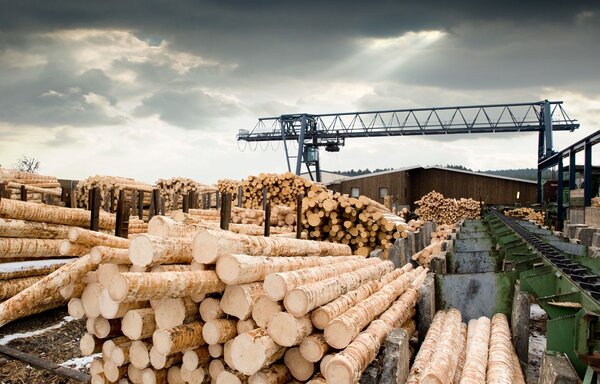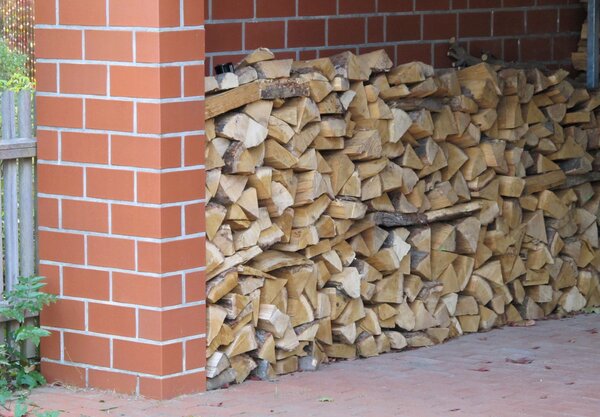Expertise
Effects on forest products markets
Holger Weimar | 08.04.2022
Russia and Ukraine play different roles on the international forest products markets. For Germany, they are important suppliers of roundwood, sawnwood, plywood or even wood pellets.

Russia and Ukraine play different roles in the international forest products markets. Russia is a major exporter of roundwood as well as processed products such as sawnwood and planed products, veneers, wood-based panels and wood pellets. Ukrainian exports play a much smaller role in the world market. The main focus here is on sawnwood and planed products, veneer and wood pellets.
In Germany, Russia ranked among the top 10 supplier countries in 2021 for the product groups 'coniferous sawnwood and planed products' as well as 'wood-based panels' and 'wood pellets':
- Sawnwood and planed products, coniferous: 17% (rank 2 among importing countries),
- Wood-based panels, fibreboard: 2% (rank 8 among importing countries),
- Wood-based panels, OSB: 2% (rank 5 among importing countries),
- Wood-based panels, plywood: 17 % (rank 1 among importing countries),
- Wood pellets: 16% (rank 3 among importing countries).
Table 1 shows that roundwood imports from Russia reached especially low quantities in 2020 and 2021, while imports of Russian coniferous sawnwood and planed products and wood-based panels (esp. plywood) increased significantly. Russia is pushing the domestic processing of roundwood. Since the beginning of 2022, Russia has imposed an export ban on coniferous roundwood and valuable hardwood species, which may further favour domestic processing of roundwood.
Table 1 shows that raw wood imports from Russia reached a low point in 2020 and 2021, while imports of Russian softwood lumber and planed products and wood-based materials (esp. plywood) increased significantly. Russia is pushing the processing of raw wood at home. Since the beginning of 2022, Russia has imposed an export ban on softwood logs and valuable hardwood species, which may further favor domestic processing of raw wood.
Tab. 1: Imports from Russia to Germany
Wood products | 2016 | 2017 | 2018 | 2019 | 2020 | 2021 |
|---|---|---|---|---|---|---|
Roundwood (non-coniferous) in m³ | 13.490 | 26.899 | 63.292 | 11.139 | 2.866 | 7.350 |
Roundwood (coniferous) in m³ | 175.310 | 86.141 | 78.417 | 75.696 | 29.342 | 27.896 |
Sawnwood and planed products (non-coniferous) in m³ | 5.702 | 3.681 | 3.749 | 4.057 | 2.074 | 5.054 |
Sawnwood and planed products (coniferous) in m³ | 590.108 | 600.991 | 653.794 | 683.412 | 766.046 | 890.079 |
Wood-based panels in m³ | 70.690 | 292.828 | 334.519 | 284.869 | 326.771 | 308.225 |
Wood pellets in t | 53.538 | 46.998 | 24.968 | 18.040 | 22.665 | 57.648 |
Wood pulp in t | 3.274 | 37.580 | 26.416 | 21.506 | 30.486 | 38.174 |
Of Ukrainian exports to Germany, non-coniferous roundwood, coniferous sawnwood lumber and planed products, and wood pellets are the most important (see Table 2). In 2021, imports of each of the above products accounted for the following share of total German imports:
- Roundwood, non-coniferous: 11 % (rank 3 among importing countries),
- Sawnwood and planed products, coniferous: 3% (rank 8 among importing countries),
- Wood pellets: 6% (rank 6 among importing countries).
While imports of non-coniferous roundwood to Germany have been relatively constant in recent years, imports of coniferous roundwood have declined significantly, probably due to the good domestic and Central European supply situation caused by high levels of damaged wood.
Tab. 2: Imports from Ukraine to Germany
Wood products | 2016 | 2017 | 2018 | 2019 | 2020 | 2021 |
|---|---|---|---|---|---|---|
Roundwood (non-coniferous) in m³ | 107.357 | 70.905 | 65.833 | 58.191 | 48.761 | 56.593 |
Roundwood (coniferous) in m³ | 10.480 | 7.724 | 7.118 | 4.225 | 3.081 | 4.010 |
Sawnwood and planed products (non-coniferous) in m³ | 26.566 | 20.389 | 11.845 | 9.908 | 10.388 | 7.628 |
Sawnwood and planed products (coniferous) in m³ | 235.590 | 253.607 | 259.014 | 178.027 | 124.066 | 132.964 |
Wood-based panels in m³ | 1.829 | 17.667 | 13.874 | 15.760 | 21.858 | 28.028 |
Wood pellets in t | 18.475 | 14.719 | 16.660 | 19.495 | 23.480 | 22.732 |
Wood pulp in t | — | — | — | — | — | — |
However, Germany has a positive trade balance for many wood products: for the product groups 'non-coniferous roundwood', 'sawnwood and planed products' as well as 'wood pellets' and 'fibreboard', and since 2019 also for coniferous roundwood, Germany exported more to other countries than it imported.
Other EU countries also trade wood products with Russia and Ukraine. Especially the countries bordering these countries import wood products. In the receiving EU countries, these imported products are further processed and then either used in their own countries or traded with other EU countries.
Different significance for the global market
Russia and Ukraine are countries that mainly export wood products. Imports of roundwood and wood products play only a minor role (<5% of world trade).
With an export volume of 16.0 to 20.1 million m³, Russian roundwood exports had a significant share in world trade (11 to 15%) in 2016 to 2020. The share of non-coniferous roundwood exports has increased from about 17 to 21%. Exports of coniferous roundwood are slightly declining, partly because of the good, calamity-related self-supply of coniferous roundwood in Europe, and partly because of Russia's objective to process roundwood more domestically. Russian exports of coniferous sawnwood, with shares ranging from 21% (25.4 million m³ in 2016) to 23% (29.8 million m³ in 2020), and veneer, with shares ranging from 11% to 15%, remain to be of greater importance.
In 2019, about 90% of Russian coniferous roundwood exports were traded to China. Other buyers were Kazakhstan (3%) and Japan (2%). The most important buyer of non-coniferous roundwood from Russia is Finland, with volume shares of about 46 to 52%, followed by China (33 to 39%) and Sweden (8 to 9%). The most important customer country for sawnwood (including planed products) is China.
Ukrainian exports are less relevant for the global forest products market. They accounted for less than 5% of world trade in recent years. Among the wood-based product groups, veneers played the most significant role with shares of about 3 to 4% (about 0.2 million m³). Ukraine exports mainly to Eastern European EU countries (including Poland, Romania, Hungary, Czech Republic, Slovakia) as well as Moldova.
What are the effects of rising energy prices?

In principle, rising energy prices initially lead to higher costs in the production of goods. In the forestry and wood-based cluster, this primarily affects the energy-intensive processes, i.e. sawnwood production including drying, production of wood-based panels as well as production of wood pulp and paper and paperboard. Rising prices generally lead to lower demand for a product.
The impact of rising energy prices on the roundwood market can hardly be estimated. Directly affected here is the harvesting of wood as well as the transport of the roundwood. Indirectly, the roundwood market is affected by the substitution of fossil energy sources for electricity and heat generation by fuelwood. According to studies by the Thünen Institute, a direct correlation between energy prices for oil and gas and the use of fuelwood in private households can be demonstrated. If the prices of fossil fuels rise, the use of fuelwood increases.
In the construction sector, cement, bricks and steel are among the materials that are produced in an energy-intensive way. If the production prices of these materials rise more sharply than those of wood, this could result in increased demand for wood products for construction.






